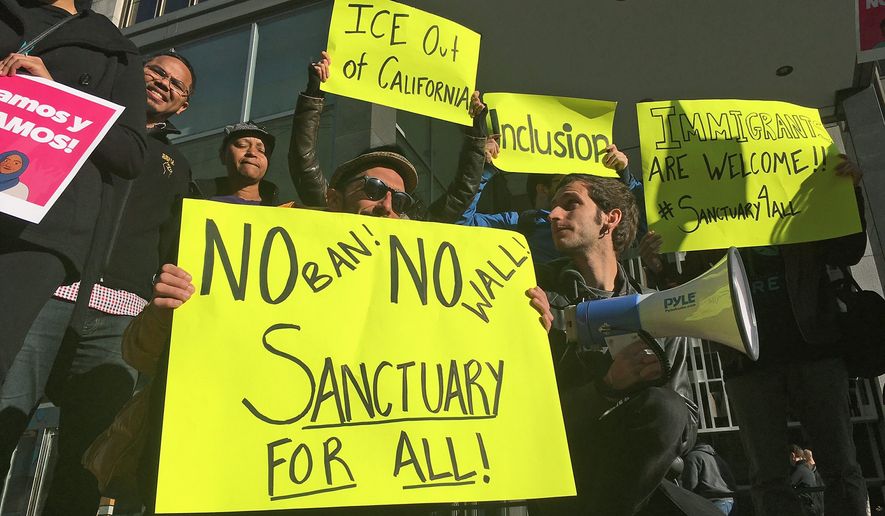About half of all Americans now live under sanctuary policies that shield illegal immigrants from law enforcement, according to the latest tally of jurisdictions that the Federation for American Immigration Reform is releasing Thursday.
FAIR calculates there were 564 states and municipalities that refuse some level of cooperation with federal immigration authorities as of April 1, up more than 200 since President Trump took office and up more than 500 compared with a decade ago. There were just 40 sanctuaries when President Obama took office.
Entire states such as California, Illinois and New York are now sanctuaries, as well as major cities and counties such as Fairfax, Montgomery and Prince George’s counties and the District of Columbia in the capital region, according to the list.
Combined, the sanctuaries on FAIR’s list cover 49 percent of the country’s population, The Washington Times calculated.
“This is just an astounding and a dramatic surge of sanctuary jurisdictions,” said Bob Dane, executive director at FAIR. “They’ve doubled in just two years, and if you game that out, if the exponential growth continues, it’s not going to be long before it’s accurate to say the U.S. is a sanctuary country.”
While there is no official definition of sanctuaries, FAIR counted any jurisdiction that bans police or other officials from asking about immigration status, forbids communication with U.S. Immigration and Customs Enforcement, or refuses to hold likely deportees for pickup by ICE.
The organization scoured local government policies, looked at press reports and used ICE’s own set of reports last year listing jurisdictions that refused to honor “detainer” requests to hold illegal immigrants.
FAIR’s numbers are higher than other counts, such as the Ohio Jobs and Justice Political Action Committee, which has been tracking sanctuaries for years, or the ICE detainer list, which was started then quickly discontinued last year.
The surge in sanctuaries began under Mr. Obama, with an average of three sanctuaries per month added during his two terms, according to FAIR statistics. Mr. Trump, meanwhile, is seeing an average of 16 new sanctuaries each month.
California looms large on the list. More than 130 of the sanctuaries are in the state — including more than 80 that are new additions to the list, reflecting the anti-Trump sentiment of the West Coast.
Some jurisdictions embrace the sanctuary label, such as the District of Columbia. Mayor Muriel Bowser says the city is proud of the work it does to shield illegal immigrants.
Others object to the label.
“Fairfax County is not a sanctuary county or sanctuary city,” Virginia’s largest jurisdiction says on its website.
Fairfax says its officials try to comply with federal laws regarding information sharing, so that makes it a “welcoming community” but not a sanctuary.
FAIR says the county is a sanctuary because it tells police not to ask about immigration status even during an arrest. The group says Fairfax also refuses to hold immigrants for pickup by ICE — a courtesy most police give to other police departments, but increasingly refuse to give to federal immigration authorities.
Fairfax officials also bowed to complaints from immigrant rights activists last month and blocked ICE representatives from speaking at a public committee meeting last month where the county’s cooperation limits were being reviewed.
Mr. Dane said that while it’s generally Democratic politicians who have defended sanctuaries, it’s up to Mr. Trump to find a way to stop them.
That means continuing to harangue Congress to pass legislation punishing sanctuaries and sending even more deportation officers into sanctuaries to go after illegal immigrants, Mr. Dane said.
“Trump owns this problem. The buck stops on the president’s desk, even though it’s not his fault,” he said.
The House last year passed a bill to crack down on sanctuary cities, but the Senate was unable to clear a Democratic filibuster when the issue came to the upper chamber this year. Just four Democrats joined Republicans in voting to crack down on sanctuaries — leaving them six votes shy of the 60-vote threshold to end the filibuster.
Sanctuary city defenders say communities of immigrants — including those in the U.S. legally — feel more comfortable knowing their local officials refuse to cooperate with the federal government. They say immigrants are less likely to report crimes if they fear they themselves will be turned over for deportation.
In the first months after Mr. Trump took office, Los Angeles Police Chief Charlie Beck said there was a marked drop in reports of rape or spousal abuse among Hispanics.
As controversial as they are, sanctuary cities have also been remarkably effective in their goal of keeping people out of the hands of ICE.
For example, jails in Southern California jurisdictions such as Los Angeles and Orange County used to provide a steady pipeline of migrants who either were in the country illegally or were in the U.S. legally but whose crimes made them deportable. With California now a sanctuary state, that pipeline is severely limited.
ICE officials say a single deportation officer sitting in a jail checking names could identify and interview perhaps 10 deportable migrants each day. But without access to jails, ICE has to send out entire teams to track down each person — a process that involves time-consuming stakeouts and the danger of an encounter in the community.
A Migration Policy Institute report this week said California accounted for 23 percent of ICE arrests in 2013 but just 14 percent in 2017.
Nationwide, sanctuaries are so effective that ICE arrests from jails and prisons have dropped from more than 85 percent of the total from 2008 to 2011 to less than 70 percent now under the Trump administration, the institute said.
• Stephen Dinan can be reached at sdinan@washingtontimes.com.




Please read our comment policy before commenting.